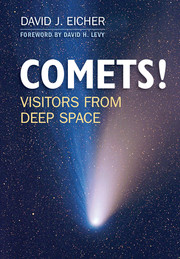Book contents
- Frontmatter
- Dedication
- Contents
- List of Figures
- List of Plates
- Foreword
- Preface
- Acknowledgments
- 1 Strange Lights in the Sky
- 2 Great Comets
- 3 What Are Comets?
- 4 Comets of the Modern Era
- 5 Comets in Human Culture
- 6 Where Comets Live
- 7 The Expanding Science of Comets
- 8 Observing Comets
- 9 Imaging Comets
- Glossary
- Bibliography
- Index
- Plate Section
Foreword
Published online by Cambridge University Press: 05 October 2013
- Frontmatter
- Dedication
- Contents
- List of Figures
- List of Plates
- Foreword
- Preface
- Acknowledgments
- 1 Strange Lights in the Sky
- 2 Great Comets
- 3 What Are Comets?
- 4 Comets of the Modern Era
- 5 Comets in Human Culture
- 6 Where Comets Live
- 7 The Expanding Science of Comets
- 8 Observing Comets
- 9 Imaging Comets
- Glossary
- Bibliography
- Index
- Plate Section
Summary
Foreword
With the appearance of two bright comets in the year 2013, sky watchers around the world are preparing to train their telescopes on this pair of wonders in the night. The starlike central portions surrounded by soft haze, and followed by gossamer tails, appear rarely enough in our lives that they surely deserve our full attention and our passion.
David J. Eicher’s book brings the magical world of comets to life. It is not an arcane mathematical textbook but a celebration of these slowly wandering objects. It delves into Tycho’s Comet of 1577, the comet that led to the great Danish astronomer’s discovery that comets pass through the sky well beyond the orbit of the Moon. The book devotes considerable space to Halley, the most famous of comets and the first comet shown to be periodic.
Comets are famous not just for what they are, but also for what they can do. In 1994 Comet Shoemaker-Levy 9 performed the first major cosmic collision witnessed by humanity when it collided with Jupiter. My role in the discovery of that comet is a story that dates back to 1965, while I was a teenage camper at the Adirondack Science Camp near Lewis, New York. Our camp director asked that each participant display a project at the camp’s annual science fair. He also insisted these projects need not be completed by the date of the fair; he wanted us to stretch our limits, to conceive and conduct a project that could last a lifetime, and one that could also fail. “Failure,” he told us, “is the great teacher. If everything you do in science is a great success, then you probably haven’t learned anything.”
- Type
- Chapter
- Information
- COMETS!Visitors from Deep Space, pp. xi - xiiPublisher: Cambridge University PressPrint publication year: 2013



